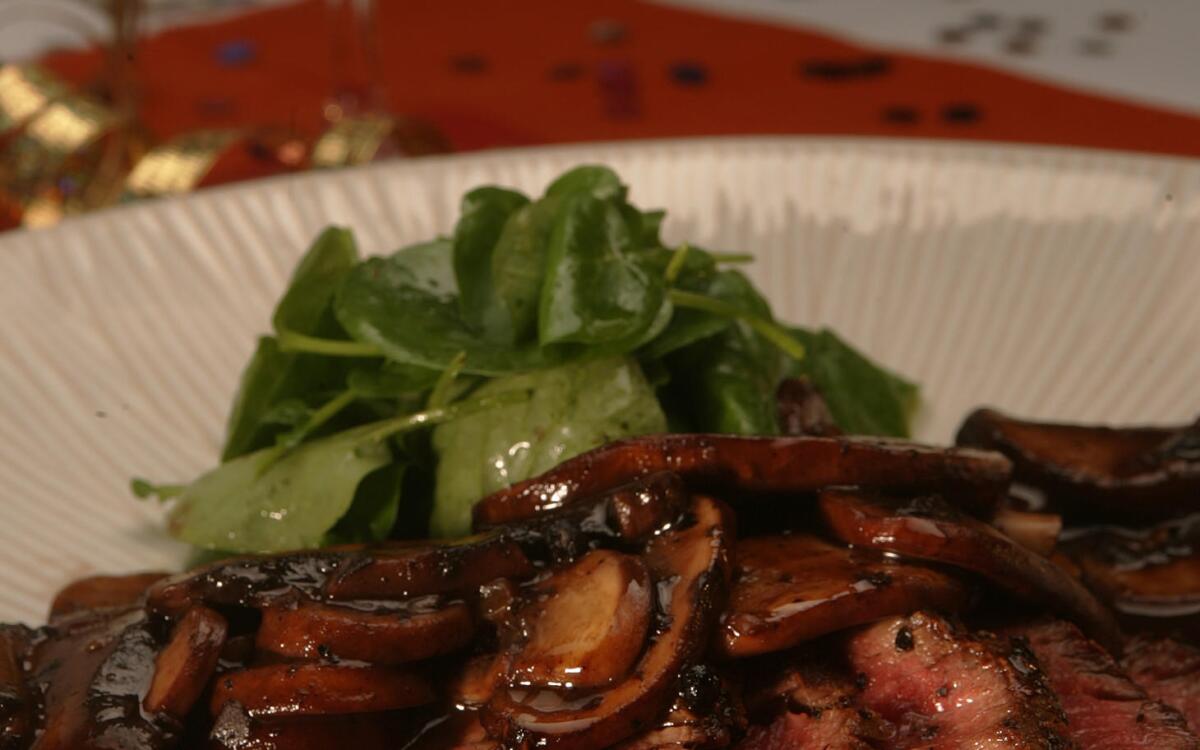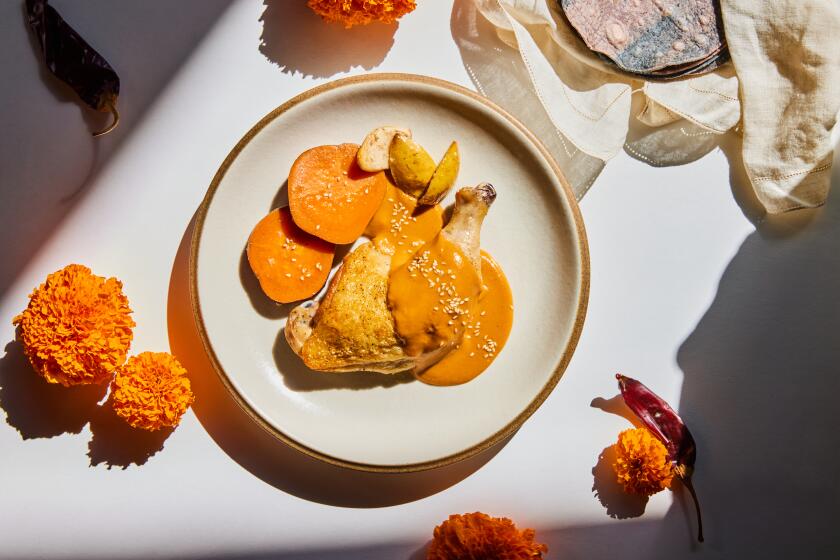Steak au poivre with portabello sauce

MAYBE it’s the corks popping, or the televised countdown, or the anticipation of all those fireworks lighting up the skies as the year ends by increments all over the world. Whatever the reason, we seem to want something a little flashier than usual for New Year’s Eve. Something dramatic. Something sparkly. So when you’re planning what to serve your guests as you wait for the year to click down, consider using actual fire. A fire in a saute pan, to be exact, or the largely forgotten art of the flambe.
Flambeing food is a spectacular, showy event -- a crowd pleaser for all ages. Adults remember campfire games or an aunt’s recipe for steak Diane; kids think Mom’s secretly been moonlighting with the circus.
But the fireworks aren’t just visual: Flambeing actually benefits the food, adding complexity to a dish and altering the flavor profile in wonderful ways.
So get out the party hats, pass the Mumm’s and usher everyone to the table for the final dinner of the year with some added pyrotechnics. Dim the lights, and over thinly sliced filet mignon, ignite a pan of caramelized portabello mushrooms. Pour flaming cherries over individual molten chocolate cakes. Sprinkle cinnamon over a pan of blazing apples and watch it sparkle as you ladle them over a waiting plate of crepes. Forget Times Square. You’ve just invented your own fireworks -- with flavor that sparkles as much as the light show.
The igniting of food for show can be traced to the 14th century, when it arrived in Europe courtesy of the Moors, who had -- not coincidentally -- also reintroduced the art of distillation. Of course you can probably date the original flambe a lot further back than that: 50,000 years or so, to the origins of domestic fire and cooking itself, which probably involved a convenient bolt of lightning or a handy forest fire.
More recently, people flambeed things in Parisian restaurants at the turn of the century and at Brennan’s in New Orleans in the 1950s. They still love to light food on fire in the long banquet halls of cruise ships and in glitzy Las Vegas restaurants. Historically it was done for dramatic purposes, often at tableside by Gallic waiters in immaculate dress, the dish ignited for suitably impressed diners who enjoyed the skill, the perceived danger, and most of all the showmanship of it all. The waiters retreated to their kitchens, their eyebrows intact. The guests tucked in to their cherries jubilee. Nothing burned down.
*
A happy accident
AS with most great inventions, modern flambeing was discovered by accident. In 1895, at the Cafe de Paris in Monte Carlo, a teenage waiter named Henri Carpentier was preparing crepes for the future Edward VII of England when he set fire to the pan of cordials he was heating. Worried about serving his guest promptly, he presented the sauce anyway, finding that the burning brought the flavors together in a way he hadn’t anticipated. The prince loved the dish, which was promptly named “crepes Suzette” for his dinner companion. Thus began a long tradition of formalized lighting-things-on-fire: hence bananas Foster, baked Alaska, steak Diane.
It was a terrific party trick because not only did it look fabulous, it also looked difficult. But as any magician can tell you, most of the technique is in the illusion, the smoke and mirrors -- not in the trick itself. In flambeing, all you’re doing is igniting the flammable material -- the alcohol -- in the pan with a match. It burns off in less than a minute, taking a lot of the alcohol with it. A very simple process, but one that looks spectacular, especially if you dim the lights first and do it in front of your guests. You can further heighten the effect if you serve the sauce while it’s still burning or add cinnamon, which, since it’s ground from bark, ignites just like tiny bits of firewood.
But flambeing doesn’t mean simply lighting a dish on fire. Igniting a cup of Cognac and pouring it over a dish looks very pretty, but that’s not flambeing. Add the alcohol to the sauce, however, and ignite it inside the pan, and you’re changing the chemistry of the food, not simply pouring your grandfather’s good VSOP over an already finished dish. The flavors meld, making them deeper and richer, sweeter and less harsh.
This makes sense, if you consider the properties of sugar and alcohol and heat. Alcohol boils at 175 degrees Fahrenheit, while the boiling point of water is 212. Sugar, in turn, caramelizes at 320. Igniting a pan that has all of these ingredients makes for a complex chemical reaction, one that has a number of very specific effects on what it is you are cooking, especially as the surface temperature of the burning alcohol reaches temperatures above 500 degrees. The water evaporates, the alcohol burns off, the sugar caramelizes in the intense heat, and the flavors recombine and intensify in ways that would not happen otherwise. When you add other ingredients, such as protein, even more complex reactions occur.
Because the alcohol reacts with the other ingredients, explains Harold McGee, author of of “On Food and Cooking: The Science and Lore of the Kitchen,” “it not only burns, it participates in the transformation and gives a different spectrum of products.” This alters the flavor the alcohol gives to the dish, transforming it from what he diplomatically calls “slightly medicinal” to something smoother and less bitter. In other words, you want the bourbon or Calvados or Armagnac in your caramel sauce to bring out the hint of cloves, of late fall apples, of black pepper -- not leave the whole thing smelling like a whisky bar.
*
A matter of proof
JUST how much alcohol is burned off depends on the technique and the duration of the cooking. Simmering dishes for two or more hours burns off as much as 95% of the alcohol, according to McGee, while flambeing usually burns off only 25%, though this percentage also depends on how thoroughly you ignite the alcohol in the pan. The proof of the spirit used is also important. Beers and wines, which have a lower alcohol content, will not flambe (so don’t get any ideas about igniting that glass of bubbly), while spirits above 120 proof are so highly flammable that they are considered too dangerous. The best to flambe with are those that are about 80 proof. Not coincidentally, these are also the spirits and liqueurs that are often the most aromatic and distinctive, the Cointreaus and the aquavits and the Cognacs, and therefore those that elevate the flavor profile of the dish.
So, to get started, take out your saute pan and make your sauce.
Whether you’re caramelizing fruit to flambe or reducing mushrooms and demi-glace to torch, the key is to cook down the ingredients so that you don’t have too much liquid in the pan you’re going to ignite; otherwise the alcohol becomes diluted and it won’t properly flambe.
*
When it’s showtime
WHEN the sauce is reduced and syrupy and bubbling, it’s time to set the stage. Plate your dishes, seat your guests, find your matches and dim or turn off the lights. Then take the sauce off the heat and pour in the alcohol.
Ignite the pan immediately and, as it burns, gently swirl the contents of the pan around. By swirling the pan you’re allowing all the raw alcohol to burn off -- this gives your audience a good show and allows you time to bring the pan to the plates, but it also caramelizes the entire dish and blends the flavors in the process. If you’re adding cinnamon, this is the time to do it. Sprinkle the shaker directly into the side of the flame and watch as the sparks rise up, swirling and eddying in the air currents as they burn. It’s quite a show, and you can ignite as much cinnamon as you like, but bear in mind that the amount of cinnamon you add will be the amount in your sauce.
As the flames subside, spoon the sauce onto the waiting plates. Take a bow. Oh, and now that the coast is clear, you can let the rabbit out of your hat too.
Crush the peppercorns in a plastic bag with a mallet or in a mortar and pestle. Combine with the salt and rub the filets with the mixture.
Heat the oil in a saute pan over high heat until just smoking. Sear the filets for 3 to 4 minutes per side (for rare) and let rest on a cutting board for 5 to 10 minutes.
Add the shallots and mushrooms to the same pan, with a teaspoon of oil if necessary. Saute over medium-high heat until the vegetables color, about 3 to 4 minutes. Remove from the heat, then add the wine and the demi-glace. Return to the stovetop and cook over medium heat. Simmer 3 to 5 minutes to reduce slightly. Cut the steak thinly on a diagonal and fan out on a plate with the watercress.
When the liquid is reduced, remove the pan from the heat and immediately add the Cognac. Ignite and gently swirl the pan. Spoon the sauce over the steaks and serve.
Get our Cooking newsletter.
Your roundup of inspiring recipes and kitchen tricks.
You may occasionally receive promotional content from the Los Angeles Times.
















